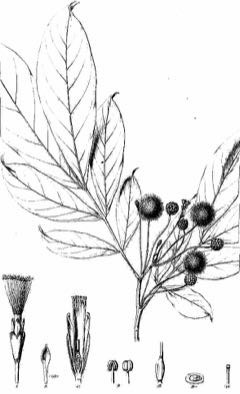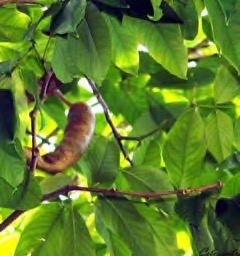 |
|
http://www.edibleplants.org |
 |
|
Translate this page:
Summary
nga cinnamomea or commonly known as Inga assu is a fast-growing evergreen tree reaching up to 25 m in height, with an open crow and cylindrical bole of up to 60 cm in diameter. It can be found in South America, particularly in Brazil, Bolivia Peru, Ecuador, Colombia, French Guiana, and Surinam. The fruit is eaten raw. The tree is often used as a shade tree in plantations. It is a natural pioneer species and has a symbiotic relationship with certain soil bacteria which form root nodules and fix atmospheric nitrogen. The wood is coarse, light in weight, and used for scaffolding, temporary constructions, boxes, etc.
Physical Characteristics

 Inga cinnamomea is an evergreen Tree growing to 12 m (39ft) by 12 m (39ft) at a fast rate.
Inga cinnamomea is an evergreen Tree growing to 12 m (39ft) by 12 m (39ft) at a fast rate.
See above for USDA hardiness. It is hardy to UK zone 10.
It can fix Nitrogen.
Suitable for: light (sandy), medium (loamy) and heavy (clay) soils and prefers well-drained soil. Suitable pH: mildly acid, neutral and basic (mildly alkaline) soils. It cannot grow in the shade. It prefers moist soil.
UK Hardiness Map
US Hardiness Map
Synonyms
Feuilleea cinnamomea (Spruce ex Benth.) Kuntze
Plant Habitats
Edible Uses
Edible Parts: Fruit
Edible Uses:
Fruit - raw[[416 ]. The seeds are covered in a dense, white aril that has a sweet flavour[416 ]. The fruit is a legume up to 30cm long and 8cm wide, containing 8 - 15 large seeds[416 ].
References More on Edible Uses
Medicinal Uses
Plants For A Future can not take any responsibility for any adverse effects from the use of plants. Always seek advice from a professional before using a plant medicinally.
None known
References More on Medicinal Uses
The Bookshop: Edible Plant Books
Our Latest books on Perennial Plants For Food Forests and Permaculture Gardens in paperback or digital formats.

Edible Tropical Plants
Food Forest Plants for Hotter Conditions: 250+ Plants For Tropical Food Forests & Permaculture Gardens.
More

Edible Temperate Plants
Plants for Your Food Forest: 500 Plants for Temperate Food Forests & Permaculture Gardens.
More

More Books
PFAF have eight books available in paperback and digital formats. Browse the shop for more information.
Shop Now
Other Uses
Containers Fuel Pioneer Wood
Agroforestry Uses: The tree is often used to provide shade in plantations, often by being left as the native forest is cleared[317 , 416 ]. A natural pioneer species within its native range, it is fast-growing and a popular food crop so should make an excellent pioneer for re-establishing woodland[K ]. Other Uses: The wood is coarse-textured, irregular to spiral-grained, light in weight, hard to cut, with a low resistance to rot[625 ]. It is used for scaffolding, temporary constructions, interior ornamental screens, boxes etc[625 ]. The wood is used for fuel[625 ].
Special Uses
Food Forest Nitrogen Fixer
References More on Other Uses
Cultivation details
Grows best in a sunny position[625 ]. Plants can withstand periodic inundation of the soil[625 ]. A fast-growing tree[625 ]. The branches are generally infested with boring ants[625 ]. This species has a symbiotic relationship with certain soil bacteria, these bacteria form nodules on the roots and fix atmospheric nitrogen. Some of this nitrogen is utilized by the growing plant but some can also be used by other plants growing nearby[755 ].
References Carbon Farming Information and Carbon Sequestration Information
Temperature Converter
Type a value in the Celsius field to convert the value to Fahrenheit:
Fahrenheit:
The PFAF Bookshop
Plants For A Future have a number of books available in paperback and digital form. Book titles include Edible Plants, Edible Perennials, Edible Trees,Edible Shrubs, Woodland Gardening, and Temperate Food Forest Plants. Our new book is Food Forest Plants For Hotter Conditions (Tropical and Sub-Tropical).
Shop Now
Plant Propagation
Seed - it needs to be sown as soon as possible once it is ripe. Sow in a partially shaded position in a nursery seedbed. Germination rates are usually almost 100%, with the seed sprouting within 10 - 20 days[625 ].
Other Names
If available other names are mentioned here
Native Range
SOUTHERN AMERICA: French Guiana, Suriname, Brazil, Acre, Amazonas, Pará, Rondônia, Bolivia, El Beni, Colombia, Vaupés, Ecuador, Napo, Pastaza, Peru, Loreto, Madre de Dios, Ucayali,
Weed Potential
Right plant wrong place. We are currently updating this section.
Please note that a plant may be invasive in one area but may not in your area so it's worth checking.
Conservation Status
IUCN Red List of Threatened Plants Status : This taxon has not yet been assessed

| Related Plants
|
| Latin Name | Common Name | Habit | Height | Hardiness | Growth | Soil | Shade | Moisture | Edible | Medicinal | Other |
| Annona vepretorum | Araticum, Pinha da Caatinga, Araticum-da-bahia | Tree | 6.0 |
10-12
| S | LMH | N | D | 4 | 0 | 2 |
| Archidendron jiringa | Jengkol, Jiringa | Tree | 20.0 |
10-12
| M | LMH | SN | M | 4 | 2 | 2 |
| Cacalia pseudo-taimingasa | | Perennial | 0.0 |
-
| | LMH | FS | M | 1 | 0 | |
| Cyperus longus | Galingale | Perennial | 1.2 |
6-9
| F | LMH | N | MWeWa | 2 | 1 | 3 |
| Drepanostachyum falcatum | Ringal | Bamboo | 3.5 |
7-10
| S | LM | S | M | 2 | 0 | 3 |
| Guibourtia pellegriana | Akume, Bubinga, Waka | Tree | 25.0 |
10-12
| S | LMH | N | M | 0 | 0 | 4 |
| Guibourtia tessmannii | Bubinga, Kevazingo | Tree | 50.0 |
10-12
| S | LMH | N | M | 0 | 0 | 4 |
| Inga densiflora | Densely flowered Inga | Tree | 15.0 |
10-12
| M | LMH | N | M | 4 | 0 | 2 |
| Inga edulis | Ice Cream Bean, Monkey Tamarind | Tree | 18.0 |
9-12
| F | LMH | SN | DMWe | 4 | 2 | 3 |
| Inga insignis | Guaba de zorro | Tree | 8.0 |
10-12
| M | LMH | SN | DM | 4 | 0 | 0 |
| Inga jinicuil | Ice Cream Bean, Jinicuil | Tree | 20.0 |
10-12
| F | LMH | N | M | 4 | 0 | 1 |
| Inga vera | Ice cream bean, River koko, Guaba, Pois Doux | Tree | 15.0 |
10-12
| F | MH | N | M | 2 | 2 | 3 |
| Microberlinia bisulcata | Zingana | Tree | 35.0 |
10-12
| F | LM | N | M | 0 | 0 | 4 |
| Microberlinia brazzavillensis | Zingana | Tree | 35.0 |
10-12
| F | LMH | N | M | 0 | 0 | 4 |
| Mimosa scabrella | abaracaatinga, bracaatinga, bracatinga | Tree | 10.0 |
10-12
| F | LMH | N | MWe | 0 | 0 | 4 |
| Moringa oleifera | Horseradish Tree, Moringa, | Tree | 8.0 |
10-12
| F | LMH | N | | 4 | 4 | 5 |
| Moringa peregrina | Moringa | Tree | 8.0 |
10-12
| M | LMH | N | DM | 2 | 2 | 3 |
| Moringa stenopetala | African horseradish tree, cabbagetree | Tree | 9.0 |
10-12
| M | LMH | SN | DM | 4 | 3 | 4 |
| Sphagneticola trilobata | Singapore daisy | Perennial | 0.4 |
9-11
| F | LMH | SN | DM | 0 | 2 | 2 |
| Syringa josikaea | Hungarian Lilac | Shrub | 4.0 |
2-7
| M | LMH | N | M | 0 | 0 | 3 |
| Syringa vulgaris | Lilac, Common lilac | Shrub | 6.0 |
3-7
| M | LMH | N | M | 1 | 1 | 3 |
| Yushania anceps | Ringal | Bamboo | 4.5 |
8-11
| | LMH | FSN | M | 0 | 0 | 2 |
|
Growth: S = slow M = medium F = fast. Soil: L = light (sandy) M = medium H = heavy (clay). pH: A = acid N = neutral B = basic (alkaline). Shade: F = full shade S = semi-shade N = no shade. Moisture: D = dry M = Moist We = wet Wa = water.
Now available:
Food Forest Plants for Mediterranean Conditions
350+ Perennial Plants For Mediterranean and Drier Food Forests and Permaculture Gardens.
[Paperback and eBook]
This is the third in Plants For A Future's series of plant guides for food forests tailored to
specific climate zones. Following volumes on temperate and tropical ecosystems, this book focuses
on species suited to Mediterranean conditions—regions with hot, dry summers and cool, wet winters,
often facing the added challenge of climate change.
Read More
Expert comment
Author
Spruce ex Benth.
Botanical References
1
Links / References
For a list of references used on this page please go here
A special thanks to Ken Fern for some of the information used on this page.
Readers comment
| Add a comment |
|
If you have important information about this plant that may help other users please add a comment or link below. Only comments or links that are felt to be directly relevant to a plant will be included. If you think a comment/link or information contained on this page is inaccurate or misleading we would welcome your feedback at [email protected]. If you have questions about a plant please use the Forum on this website as we do not have the resources to answer questions ourselves.
* Please note: the comments by website users are not necessarily those held by PFAF and may give misleading or inaccurate information.
To leave a comment please Register or login here All comments need to be approved so will not appear immediately.
|
Subject : Inga cinnamomea
|
|
|
|